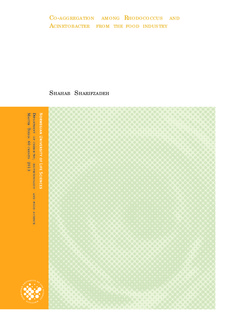| dc.description.abstract | Microorganisms’ attachment to surfaces and consequently biofilm formation creates problems in food production industries. Such problems include contamination of equipment and products. Biofilm development is the result of cell-cell interaction between pairs and different groups of bacteria. Co-aggregation is one of the main cell-cell interactions, which result in bacterial adherence and biofilm development.
This study was conducted to find out about the effects of physiochemical factors on co-aggregation between Rhodococcus and Acinetobacter from the food industry. In addition, it was intended to characterize the mechanisms that mediate co-aggregate formation between these two strains. Co-aggregation between Rhodococcus erythropolis and Acinetobacter calcoaceticus, isolated from food production environments, was studied by a visual assay and an optical density assay. Strains were tested under different physicochemical conditions such as various growth temperatures (20oC, 30oC), growth mediums (R2A, TSB), and physiological culture status. These tests showed that the highest co-aggregation ability could be reached when the cells were grown in TSB at 30oC and harvested either in the exponential phase or early stationary phase.
To find out the effect of various washing solutions on co-aggregation ability, the cells that were washed with dH2O and co-aggregation buffer (three times) were compared. In both cases the cells showed equal co-aggregation ability. To study the effect of different solutions and buffers on co-aggregation, the cells of Rhodococcus erythropolis MF3727 and Acinetobacter calcoaceticus MF3293 were re-suspended in H2O, co-aggregation buffer, 0.85% NaCl, TSB, and R2A. Highest co-aggregation ability was registered for those cells which were re-suspended in Co-aggregation buffer and 0.85% NaCl.
In the current study, the co-aggregation possibility between three different strains of Rhodococcus and eight strains of Acinetobacter was also tested. The achieved results showed that only Rhodococcus erythropolis MF3727 + Acinetobacter calcoaceticus MF3293, Rhodococcus erythropolis MF3727 + Acinetobacter calcoaceticus MF3627, and Rhodococcus erythropolis MF3727 + Rhodococcus erythropolis MF3803 had the ability to form co-aggregates.
Enzymatic treatment (proteinase K) and heat treatment (85oC, 30 min) could inhibit the co-aggregation in all cases where MF3293, MF3627, and MF3803 had been treated. These treatments had no effect on MF3727 co-aggregation ability. These results suggested that MF3293, MF3627, and MF3803 have protein adhesins on their cell surface which mediates their co-aggregation with MF3727. To indicate present sugars in the structure of MF3727 co-aggregation receptors, co-aggregation was tested in the presence of simple sugars such as lactose monohydrate, D (+) galactose, α-L-fucose, N-acetyl-D-galactosamine, D (+) glucose and D-mannose. None of these sugars could completely inhibit co-aggregation between pairs. The strongest inhibitory effect was observed for N-acetyl-D-galactosamine, which managed to inhibit coageration between MF3727 and MF3627 by 46%. These results could suggest the existence of multiple co-aggregation mediating receptors on the cell surface of MF3727.
In this study, the effects of pH on co-aggregation between MF3727 + MF3293, MF3727 + MF3627 and MF3727 + MF3803 in pH range from 1 to 14 were examined. The results showed that all pairs had the ability to form co-aggregation in pH between 3 and 11. According to the results, MF3727 + MF3803 obtained the highest percentage of co-aggregation at pH of 3 and 4. On the other hands, MF3727 + MF3293 and MF3727 + MF3627 showed a wider optimum pH range. To investigate the prevalence of co-aggregation between other food related bacteria, 466 possible combination pairs from a total of 78 strains were tested under standard conditions. No co-aggregation was observed between any of the pairs. | no_NO |
